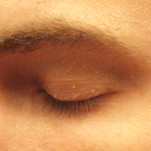What Is Milia?
 Milia is a skin condition that can happen to anyone at any time in life. It is most often seen in newborns, and it can be expected to rapidly disappear in these cases. The biggest problem with milia occurring in infancy is calming panicked parents, who do not know how harmless and temporary it is. Milia may not be so temporary when adults get it. In fact, these unsightly blister-like bumps can sometimes be permanent for adults without intervention.
Milia is a skin condition that can happen to anyone at any time in life. It is most often seen in newborns, and it can be expected to rapidly disappear in these cases. The biggest problem with milia occurring in infancy is calming panicked parents, who do not know how harmless and temporary it is. Milia may not be so temporary when adults get it. In fact, these unsightly blister-like bumps can sometimes be permanent for adults without intervention.
Milia visibly manifests in tiny blister-like protrusions on the skin. This condition can occur in anyone, regardless of age, sex, or race. The type seen in infants usually disappears over a brief period, but the adult version can be a long term cosmetic problem. This condition is not dangerous, and it is officially unknown if there is a relationship to another underlying condition. Milia is one of the most misunderstood of all health conditions, but in itself, appears harmless by all reports.
Big Medica: "The Causes"
These are the suspected causes of adult milia, as espoused by modern medicine, listed for humor purposes, of course. You may notice the trend of these being related to their own chemical industry.
- Trauma to sweat ducts
- Radiotherapy (radiation)
- Sunscreens
- Topical corticosteroid use
- Genodermatoses ("bad" genes) **
The Real Cause
Unfortunately, we cannot give answers as definitively as we usually do. This is because milia has not received the same amount of research that most disorders have, due to its relatively harmless nature.
The honest truth is that no one knows the causes with certainty. It is widely believed that this condition is due to an exfoliation problem, whereby tiny flakes of dead skin clog the skin's pores. Our research indicates that this is likely only half of the equation. The other half is an excess of cholesterol in the skin, where the body frequently deposits its excess cholesterol. This in turn, leads us to a third contributing factor, which is a deficiency of sunlight. A body removes its excess cholesterol in the skin using sunlight, which begins a process of converting it into vitamin D3. Sunlight does not cause this condition, as some other health-related sources have claimed, and in fact, sunlight can cure it in some cases.
Eliminating Milia
There is plenty of information elsewhere about having dermatologists remove these lesions, so we shall not discuss that option. For those who want to do it themselves, we recommend:
- Take frequent showers.
- Exfoliate the skin.
- Supplementation with niacin is the single most effective treatment for some sufferers.
- Avoid sunscreens. (when reasonable)
- Avoid heavy facial cosmetics.
- Get moderate sunlight exposure frequently.
- Reduce high cholesterol foods.
- Supplement with biotin, because many sufferers find that biotin supplementation alone cures their milia.
- Do not take vitamin D supplements. *
- CoQ10 is produced by the body during intense exercise, and is found in meat and fish. It is used by the body to emulsify oils, and to increase energy. Emulsifiers make oils water soluble (like soap), which assists in their removal, and thus reduces milia.
- A good facial mask containing oatmeal can be helpful in some cases.
- For stubborn milia, freezing them with a commercially-available wort remover product usually works. Note that it will usually make a pop sound when a bump is frozen. It will then dry over the period of a week, and peel off. This does not cause scarring.
* The liver maintains healthy skin while converting the vitamin D2 from sunlight into vitamin D3. Since supplementation with vitamin D can eliminate the need for the liver to conduct this process, it is not always wise to take a vitamin D supplement while attempting to correct a skin issue.
Related Articles
Sunscreen Lies and Cosmetic Trade Secrets
